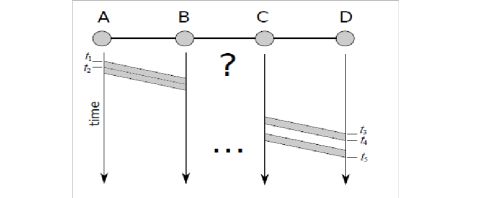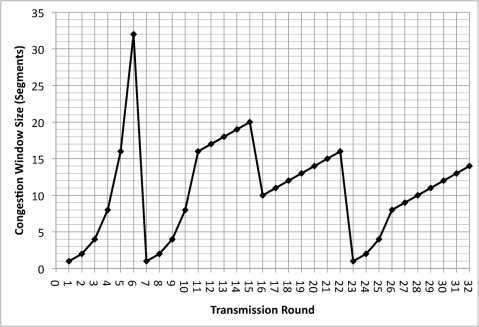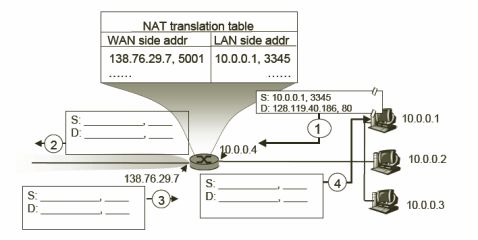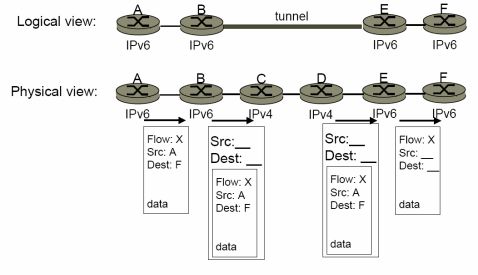中山大学20xx软件学院计算机网络期中考试题目
1. Bandwidth and Delay
a. On a generic multi-hop network, explain the potential causes of delay for a packet:
? Propagation delay:
? Transmission delay:
? Queueing delay:
? Processing delay:
b. For a fixed network path, which of these delays are constant over time, and which ones vary with load? Explain why.
c. (Estimating bottleneck bandwidth). An interesting technique used to estimate the bottleneck bandwidth in a network is called packet pair. The idea is simple: you send two packets back-to-back (no gap), at the full bandwidth of the first hop. The receiver at the other end can then determine the bandwidth by measuring the delay between the receptions of the two packets. In this problem we will do just that, with a simplified 3-link network shown in the figure below, with no extra traffic, no queues, and instantaneous access to the medium.
Setup: In the figure, assume there is no queueing or processing delay, and that nodes can forward a packet as soon as (a) all bytes for the packet have been received from the previous link, and (b) the outgoing link is free. All three links have a propagation delay of 10ms; link AB has a bandwidth of 10Mbps ((107 bits per second), and link CD has a bandwidth of 8 Mbps (8 × 106 bps). You send two probe packets of 1000 bytes each, as depicted in the figure.
(a) In this setup, calculate the length of the interval t1t2 in the figure. Do the same for t3t4
(b) In the diagram, draw the transmission of the two packets in the link BC

, paying attention to when they must start and when they must end.
(c) You measure the delay t4t5 between the end of the receptions of the two packets to be 8 ms. Assuming that the link BC is the bottleneck bandwidth in the path, what is its bandwidth? Explain your reasoning.
2. Answer the following questions regarding TCP, UDP, IP, and routing:
a) What are the important fields in the TCP, UDP, and IP headers? Without these fields, the protocols would clearly not “work”.
b) Sketch the TCP connection initiation and connection termination packet flows using a timing diagram.
3. Socket Programming
3.1. Consider the following Java application:
socket = new DatagramSocket(12345);
while (true) {socket.receive(packet);}
What happens if somebody decides to run two instances of this
application on one machine and 4 UDP segments arrive at port 12345?
a) both instances of the application receive all 4 segments
b) one instance receives all 4 segments
c) some segments are received by one instance, other segments are received by the other instance
d) one instance receives segments 1 and 3, the other receives segments 2 and 4
3.2. Given the following lines from a Java program segment:
byte[] dataOut = new byte [512];
String userInput = inFromUser.readLine();
dataOut = userInput.getBytes();
Which of the following lines of code could be used to create a new UDP datagram packet to send the data that was provided by the user to a host identified by the InetAddress object IPAddress?
a) DatagramPacket packetToSend = new
DatagramPacket(dataOut, dataOut.length, IPAddress)
b) UDPPacket = new UDPDatagram (userInput,
userInput.length, IPaddress, 9876)
c) DatagramPacket packet = new DatagramPacket(dataOut, dataOut.length, IPAddress, 9876)
d) Socket datagramSocket = new dataGramPacket(dataOut, IPAddress)
3.3.
Consider a server socket object
socket = ServerSocket(12345);
What does the invocation of socket.accept() return?
a) 'true' if there is a new TCP segment in the socket's buffer, false otherwise
b) a new TCP segment from the socket's buffer (blocks if no segments are available)
c) 'true' if a new TCP connection request has arrived, false otherwise d) a socket associated with a new TCP connection (blocks if no
connections are available)
3.4.
Assume the following two lines of code are to be executed on the machine blue.cse.yorku.ca:
Socket myFirstSocket = new Socket("blue.cse.yorku.ca", 5555);
Socket mySecondSocket = new Socket(5555);
Are the two lines/commands in conflict? Explain briefly!
3.5.
Suppose application A is using a UDP socket, i.e. DatagramSocket(), to transfer data to application B
on a remote host. Suppose application A calls send() method on the given socket 10 times.
a) Can the underlying network stack transmit more than 10 data packets? b) Can the underlying network stack transmit fewer than 10 data packets? Explain briefly!
4. The Transmission Control Protocol uses a method called congestion control to regulate the traffic entering the network. The behavior of TCP congestion control can be represented as a graph in which the x-axis indicates the time, and the y-axis indicates congestion window size. Please use the graph shown below to the answer the following
questions. Note that the graph does not explicitly show timeouts, but you should be able to figure out when timeouts happened based on the events shown.
(a) Slow Start: give two reasons why slow start is used, and explain why it does a better job than congestion avoidance for that function.

(b) Slow Start: identify the intervals of time when TCP slow start is operating. For each interval, identify which of the above reasons apply and do not apply and explain why.
(c) Congestion Avoidance: identify the intervals of time when TCP
congestion avoidance is operating. Why should congestion avoidance be used instead of slow start during these intervals? Please clearly identify one specific reason.
(d) Fast Retransmission: identify the intervals of time when TCP fast
retransmission is used. Please explain what fast retransmission does and how it is triggered.
(e) Fast Recovery: identify the intervals of time when TCP fast recovery is operating. What does fast recovery do and explain why is it beneficial.
(f) Lack of fast recovery: identify the interval(s) of time when fast recovery could have happened, but did not. Identify one specific example of a circumstance that may prevent fast recovery from happening.
5. NAT and IPv6
5.1 Assume an IP packet carrying an HTTP request is going from a local (i.e. home) area network onto the wider Internet through a NAT router. Name all header fields that the NAT router needs to change in the given packet? Explain your answer. (Hint: encapsulation as well as the syntax/semantics of all involved protocols must be taken into consideration.)
5.2 The diagram below shows a packet traveling through a NAT router. Packet 1 is sent from the internal host (S) to the NAT router, packet 2 is sent from the NAT router to the external web server (D), packet 3 is received from the web server by the NAT router, and packet 4 is sent by the NAT router to the original host. Fill in the missing source and destination IP addresses and port numbers in packets 2-4.
5.3 The diagram below shows an IPv6 packet tunnelled over IPv4. Fill in the
missing source and destination addresses at places/packets marked 1, 2, and 3.
6.


Consider a datagram network using 32-bit host addresses. Suppose a
router has four links, numbered 0 through 3, and packets are to be forwarded to the link interfaces as follows:
Destination Address Range Link Interface 11100000 00000000 00000000 00000000 Through (0)
11100000 00111111 11111111 11111111
11100000 01000000 00000000 00000000
Through (1)
111100000 01000000 11111111 11111111
11100000 01000001 00000000 00000000
Through (2) 11100001 01111111 11111111 11111111
Otherwise
a) Provide a forwarding table that has five entries, uses longest prefix (3) matching, and forwards packets to the correct link interfaces.
b) Describe how your forwarding table determines the appropriate link interface for datagrams with destination addresses(following): 11001000 10010001 01010001 01010101
11100001 01000000 11000011 00111100
11100001 10000000 00010001 01110111
-
大学计算机基础学习心得
大学计算机基础学习心得计算机,即电脑,随着科学技术的发展,不断进行着更新发展。伴随着计算机走入人类生活,它已成为人们日常生活必不可…
-
大学计算机基础总结与复习
大学计算机基础总结与复习第1章计算机的基本概念11计算机概述1电子计算机电子模拟计算机电子数字计算机2现在所用的计算机绝大多数是电…
-
大学计算机基础知识点总结
大学计算机基础知识点总结第一章计算机及信息技术概述了解1计算机发展历史上的重要人物和思想1法国物理学家帕斯卡16231662在16…
-
大学计算机基础超详细知识点(高手总结)免费
第一章计算机及信息技术概述1电子计算机的发展历程19xx年2月由宾夕法尼亚大学研制成功的ENIAC是世界上第一台电子数字计算机诞生…
-
大学计算机基础实验体会
大学计算机基础实验体会大学计算机基础这门课是一门基础应用类课程目的是让我们了解计算机硬件组成简单的运行原理以及各类常用软件的使用这…
-
中学、大学生个人期末总结 精选3篇
范文一:大学生个人期末总结时光像水中的倒影,一晃一学年就过去了。昨日那埋怨时间过的太慢的情素似乎还游移在脑际,而今大二的生活正在向…
-
河南理工大学高职学院20xx-20xx学年第一学期期中教学检查总结
河南理工大学高职学院郑州校区20xx-20xx学年第一学期期中教学检查工作总结20xx年x月x日,河南理工大学高职学院对郑州校区进…
-
大学期中工作总结
期中工作总结本学期进入到了最关键的时候,许多同学开始为自己的将来打算了,或考研或考公务员或毕业直接找工作,或者多考一些证书,同学们…
-
大一上学期期中总结
12人力班生活委员期中总结进入大学后,感到每件事物都是新鲜的,其中包括环境、学习、同学等等。而在这两个月之内我也有许多感悟和体会,…
-
大学生期中报告总结
期中报告总结从我踏进实习单位的那一刻起,我就知道我将经历一段特殊的不平凡的并且充满收获的人生旅程,那旅程必定在我的生命中写下浓墨重…
-
大学期中总结
总结不知不觉,大学生活已开始了三个月了,突然间发现,时间是如此的匆匆,如此的无情,但又是如此的现实。回首这三个月,我远离家乡,远离…